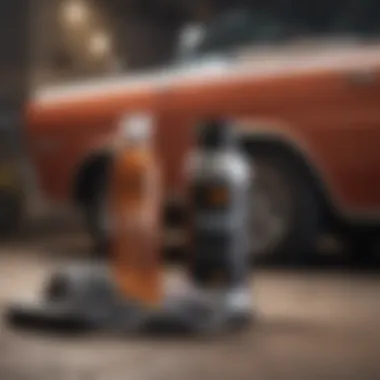Ultimate Guide to Deep Cleaning Car Upholstery Techniques


Intro
Maintaining the aesthetic and functional integrity of car upholstery is fundamental for automotive enthusiasts and everyday drivers alike. Deep cleaning your vehicle's interior not only improves visual appeal but also enhances the overall driving experience. This guide dissects the various aspects of car upholstery cleaning, exploring distinct materials, optimal tools, and step-by-step procedures for achieving cleanliness. Moreover, practical tips for upholstery maintenance and troubleshooting common cleaning challenges will be invaluable for anyone wishing to keep their vehicle interior in top shape.
In-Depth Car Reviews
Overview of the Vehicle
Understanding the vehicle's upholstery type lays the groundwork for effective cleaning strategies. Materials such as fabric, leather, and vinyl all require different approaches and techniques. Comprehensive knowledge about the vehicle not only makes cleaning processes clear but also helps in preserving the upholstery.
Key Specifications
Each vehicle's upholstery comes with a set of specifications. For example, the Mazda CX-5 features premium leather seats while the Toyota Corolla may include cloth upholstery. Knowing the differences aids in selecting the correct cleaning tools and supplies, ensuring a focused approach towards fabric care.
Performance Analysis
Evaluating how upholstery holds up against stains and wear enhances the deep cleaning experience. Different fibers react uniquely to cleaning agents. Following an assessment after cleaning can show the quality of various materials in terms of longevity and ease of maintenance.
Interior and Exterior Design
The integration of exceptional upholstery within overall vehicle design elevates both comfort and aesthetics. Luxurious materials often require more specialized care. Thus, knowledge of additional protection solutions such as sprays and conditioners tailored for leather and fabric becomes essential.
Safety Ratings and Features
While focusing on cleanliness, it is right not to overlook the àssociations between well-maintained upholstery and safety features, including airbags and seatbelt designs that may also affect how easily you keep your car clean. Keeping the seating quality shall foster greater appeal and prolong resilience.
Cleaning Tools and Supplies
Essential tools for deep cleaning:
• Vacuum cleaner: Prefer a wet-dry option for versatility.
• Soft-bristle brush: Ideal for loosening dirt and grime.
• Microfiber cloths: These gently lift dirt without scratching.
• Upholstery cleaner: Choose products appropriate for your specific material.
Equipping oneself with these ensures readiness for effective cleaning sessions.
Technological Trends
Latest Innovation Highlights
Automotive maintenance technology has improved significantly in recent years. Smart cleaning devices that use ultraviolet light to kill bacteria, for instance, are becoming more popular among auto maintenance enthusiasts, solving problems with mold and odor.
Impact of Technology on Cleaning Efficacy
Modern cleaners can penetrate fabric boundaries, offering thorough cleaning that traditional methods could not achieve. Features like steam cleaning technology give the ability to sanitize surfaces without chemicals, making it a superior selection for various materials.
Prelude to Car Upholstery Cleaning
Cleaning car upholstery is crucial for several reasons. Over time, various factors can lead to the degradation of your vehicle's interior. Dust, crumbs, stains, and odors accumlate, diminishing the driving experience. Deep cleaning not only enhances the aesthetic appeal but also protects your investment. A clean upholstery can improve resale value and make a lasting impression on passengers.
Maintaining clean car upholstery involves a better understanding of the various upholstery types. Knowing what materials comprise your car's seats is essential as each type requires a different approach. Failing to recognize these necessary differences can lead to damage or ineffective cleaning.
"Misunderstanding care requirements for different materials can severely compromise their life span."
Considering the comfort and health benefits of cleanliness, it’s clear that routine care and detailed cleaning strategies are vital. This journey into the complexity of your car’s inner environment helps you achieve both comfort and hygiene.
Importance of Deep Cleaning
Deep cleaning sets itself apart from regular exterior washing and surface-level cleaning. It goes beneath the visible layer, targeting allergens like dust mites and mildew that can impact health. The process removes embedded dirt and stains, breathing fresh life into the car's interior. Such thorough cleaning ensures that foul odors are eliminated and may even help to extend the lifespan of the upholstery.
Effectively executing this task can also foster a sense of pride in ownership. Knowing that your vehicle's interior is clean brings satisfaction while enhancing the driving experience.


Understanding Different Upholstery Types
Every vehicle boasts a unique upholstery type, necessitating varied cleaning methods.
Fabric Upholstery
Fabric upholstery features diverse textures and patterns. Its primary virtue lies in comfort. This type is often in popular economy cars, surprising in luxurious vehicles too. Fabric is favored for its softness and warmth. However, it can absorb spills and odors easily.
Cleaning fabric demands vigilance and regular attention. Accidents can stains your upholstery if left untreated. When choosing cleaning products, always investigate absorbency. The key characteristic of fabric is its ability to bond with particles. As such, general cleaning solutions can sometimes be ineffective. Utilizing steam cleaning or specially formulated upholstery cleaners can be beneficial. A possible drawback is that fabric upostery can wear down structurally over time, especially with sunlight exposure.
Leather Upholstery
Leather upholstery conveys an air of sophistication. It is revered for durability and ease of cleaning. The richness of leather itself makes it impeccable for high-end vehicles. Leather often only requires surface dusting with approved cleaners followed by conditioning to prevent cracking.
However, leather often lacks comfort compared to fabric, especially during hot or cold weather. Additionally, scratches can worsen over time, so preventive care is essential to sustain its elegance. Proper maintenance routines involve using appropriately detailers tailored for leather care to prolong its superior attributes.
Vinyl Upholstery
Vinyl is known for its durability and accessibility. It offers water-resistant properties, maintaining an enduring aesthetic with minimal upkeep. Its flexibility allows it to replicate the look of leather without the high cost, making it a viable option for budget-conscious eters.
It generally withstands more varied treatments but can also fade over time due to sun exposure. A critical maintenance tip is using a soft cloth with a gentle cleaning solution. The key characteristic thus remains practicality coupled with affordability. Consequently, while vinyl comes with advantages, being attentive to its drawn longevity may save future expenses.
Necessary Tools and Supplies
When it comes to deep cleaning car upholstery, having the right tools and supplies is crucial. The proper equipment streamlines this task, saves time, and enhances the effectiveness of the cleaning process. Each tool serves a specific purpose and contributes to achieving a thorough clean.
Basic Cleaning Tools
Vacuum Cleaner
A vacuum cleaner is one of the most important tools for car upholstery cleaning. It helps remove loose dirt, dust, and debris from the fibers of the upholstery before any deep cleaning begins. Many people choose a handheld vacuum for its convenience and portability.
One key characteristic of vacuum cleaners is their power to suction. This feature allows for effective removal of dirt that might otherwise settle into the upholstery. It's a valuable asset because it ensures the cleaning solutions can work more effectively on clean surfaces. An advantage of a vacuum is its ability to reach tight spaces within the vehicle.
However, vacuum cleaners can vary widely in their features. For instance, some models come with attachments specifically designed for upholstery. Using the correct nozzle makes it easier to extract dirt from seams and in between cushions.
Brushes
Brushes play a significant role in car upholstery cleaning. They help in loosening debris and dirt from the fabric or leather. Different types of brushes are available designed specifically for various upholstery materials.
A key feature of brushes is their bristle strength. Softer bristles are ideal for delicate fabrics, while stiffer bristles can effectively clean more robust materials. Select choice because ?they can easily agitate dirt, allowing the cleaning solution to penetrate deeper into the upholstery.
One downside could be the risk of damaging certain materials if brushes are too stiff. As a rule, always test a small area first.
Microfiber Cloths
Microfiber cloths are also essential in the cleaning toolkit. They are remarkably effective and gentle on various upholstery materials. A major aspect of microfiber cloths is their ability to trap dirt and dust particles. This makes them ideal for wiping down surfaces after applying cleaning solutions.
The key characteristic of microfiber cloths is their softness. They won't scratch delicate surfaces, which is critical when dealing with luxury interiors. The capability to rinse and reuse these cloths several times makes them economical.
On the other hand, if not washed properly, they can also retain chemicals or oils, which might lead to unwanted streaking if reused without cleaning. Ensure to have enough on hand to switch them out between various material types.
Cleaning Solutions
After gathering tools, the choice of cleaning solutions is vital for effective results. Different appropriate solutions help in targeting tough stains while preserving the integrity of upholstery materials. Understanding the benefits and potential drawbacks of each category will enhance your cleaning effectiveness.
Commercial Cleaners


Commercial cleaners are formulated specifically to tackle upholstery cleaning challenges. They usually come with specific instructions for application to ensure the best results. One of their most significant benefits is the professional-grade potency in dealing with stubborn stains.
It is also popular, is their consistent performance since they undergo rigorous testing before being sold. Common formulations cater to specific materials, such as leather, vinyl, or fabric.
However, they can include harsh chemicals. A downside is the possibility of these chemicals affecting sensitive upholstery or sometimes unnecessary as common stains can easily be managed with DIY options. Balance is essential when deciding.
DIY Cleaning Solutions
DIY cleaning solutions offer a more accessible and often less expensive method to clean car upholstery. Many items found at home can be effective in treating stains. Basic components like vinegar, baking soda, and mild soap can provide excellent cleaning results without harmful chemicals.
A major feature of these solutions is their safety profile. They tend to be gentle, making them good for families or environments sensitive to harsh chemicals. Another key advantage is the ability to customize the solution according to the specific problems you encounter.
Nevertheless, it’s essential to know that homemade cleaners may lack certain specific functionalities that commercial products offer, especially with tough stains. Proper research is always recommended before proceeding.
The choice of the right tools and cleaning solutions can make a drastic impact on achieving quality cleaning.
Step-by-Step Deep Cleaning Process
Deep cleaning car upholstery is essential for maintaining the aesthetic and hygienic quality of your vehicle's interior. This step-by-step process outlines key actions that ensure a thorough cleaning. Skipping this phase can result in lingering odors and stubborn stains, which are harder to tackle later. A diligent approach not only enhances visual appeal but also contributes to longevity, making it vital for car owners and automotive enthusiasts.
Preparing the Vehicle
Prep time is crucial. Before engaging in deep cleaning, remove all personal items, trash, and floor mats from the vehicle. This decluttering makes it simpler to access every inch of the upholstery. Also, consider adjusting the seats to enable easier cleaning of hard-to-reach areas. Secure the plastic covers over electronic components to prevent water damage, and ensure windows and doors are closed to limit dust intake.
Vacuuming
Vacuuming is the first practical step in the cleaning process. Utilize a vacuum with strong suction and a suitable attachment to reach crevices. Focus specifically on seats, floor mats, and under seats. This process removes the larger particles of dirt and debris, creating a clean foundation for deeper cleaning. Ensure that all nooks are addressed, as dirt accumulation here can lead to unpleasant odors and deterioration of the material over time.
Spot Cleaning Stains
Addressing stains individually can save both time and frustration. Begin by identifying stain types—whether they are from liquids, food, or other materials. Use a gentle stain cleaner, adhering to the manufacturer’s instructions. Work with soft cloths or sponges to dab at the stain, never rub, as this can worsen it. If a stain persists, consider using a steam cleaner, which can dissolve stubborn residues without chemicals. Targeting stains initially can streamline the subsequent cleaning stages.
Deep Cleaning Fabric Upholstery
For fabric cleaning, follow specific products designed for upholstery. Spray the cleaner uniformly, then gently agitate the material using a brush. Avoid oversaturating the fabric; this can lead to mildew. Afterward, use a microfiber cloth to extract dirt thorough washing or even a steam cleaner can provide profound results. Maintain consistent pressure but moderate brush strokes, ensuring not to damage fabric fibers.
Deep Cleaning Leather Upholstery
The approach is different for leather. Start with a soft brush to remove crumbs and debris, then apply a leather cleaner to a cloth—never directly on the leather. Wipe the surface gently. Rinse the cloth and repeat as necessary, getting into grain patterns for a deep clean. Once done, consider applying a leather conditioner, which helps preserve suppleness and protects against cracks. Focus on maintaining the beauty of the material while ensuring durability for service in years to come.
Key Consideration: Always test cleaning solutions on inconspicuous areas to prevent discoloration or damage.
Post-Cleaning Maintenance Tips
Maintaining your car upholstery after a deep cleaning is vital for long-term preservation and freshness. Post-cleaning maintenance helps reduce wear and tear on materials and extend their life. Moreover, keeping your car's interior clean translates to a more pleasant driving experience. By following some tips, you can keep your upholstery looking new.
Protecting Upholstery from Future Stains
Stains can appear quickly on car upholstery. Protecting it requires proactive measures. One strategy is to apply stain repellents specifically designed for different materials. Look for products like Scotchgard for fabric or Leatherique for leather. These fleece often create a barrier that repels spills and dirt, making future clean-ups easier.
Another approach is to keep a collection of cleaning wipes conveniently stored in the car. This can be useful for immediate response to spills from drinks or food. Make sure the wipes are suitable for your upholstery type, as certain materials might be damaged by harsh chemicals. Regular wiping down of high-contact areas can help maintain cleanliness as well.
To further guard against stains, establish a no food and drink policy when possible, particularly in newer vehicles.
Regular Care and Maintenance
Regular care is crucial in decluttering and preserving upholstery. Setting a schedule for maintenance work makes it easier to stay on top of things. Weekly vacuuming can help remove dirt and debris effectively. Soft brush attachments for vacuum cleaners can be friendly to delicate materials, reducing the risk of damage.


- Monthly Spot Cleaning: Devote time once a month to handle any persistent spots or stains. Use mild cleaners based on the upholstery type for best results.
- Deep Cleaning Schedule: Plan for a thorough cleaning every six months, which keeps the interior fresh and extends the upholstery's lifespan. This deep cleaning can follow the previously detailed methodologies.
It is also wise to routinely check your car for new wear signs. For example, if you detect fading on leather seats or discoloration of fabric, it's essential to react accordingly. Quick action can mean the difference between a simple fix and complete upholstery replacement.
Effective post-cleaning maintenance helps ensure the longevity and cleanliness of your car upholstery, making the effort invested in deep cleaning worthwhile.
Constituting a basic maintenance plan can notably improve your vehicle's aesthetics. By taking these steps, the work done to deep clean your upholstery will be supported over time, keeping your car looking well cared-for.
Common Challenges in Upholstery Cleaning
Cleaning car upholstery can be more intricate than it may initially seem. While basic cleaning might seem sufficient, many car owners overlook specific obstacles that arise during detailed cleaning processes. These challenges include persistent stains, unpleasant odors, and the task of maintaining upholstery after cleaning. Addressing each of these factors not only ensures the cleanliness of your vehicle but extends the lifespans of the upholstery and enhances your driving experience.
Dealing with Stubborn Stains
Stains can take many forms, from food spills to ink marks. Eliminating them often requires special attention and an understanding of upholstery fabric types. Different materials react distinctively to cleaning agents, making it essential to identify the source of the stain before acting.
- Assessing the stain: Determine what caused the stain. For example, oil-based stains require different treatments compared to water-soluble ones.
- Testing cleaners: Before applying any cleaner, test it on an inconspicuous area of the upholstery to check if it causes discoloration or damage.
- Using appropriate techniques: Blotting the stain gently prevents it from spreading. You can use specialized upholstery cleaners or basic options like diluted vinegar for many stains.
By following these methods, you can significantly improve your chances of total stain removal.
Handling Odors
Odors can linger in car upholstery and often arise from sources like spills or pets. Simply spraying air fresheners won't address the underlying issues. Effective odor control requires a more hands-on approach.
- Thorough cleaning: Begin by deep-cleaning the upholstery as mentioned earlier. Coffee, smoke, and food odors can permeate fabrics significantly.
- Natural deodorizers: Consider the application of baking soda, which absorbs odors effectively. Sprinkle it on the upholstery, let it sit for a few hours, then vacuum it away.
- Steam cleaning: This method not only eliminates dirt but also freshens the fabric. The heat can extract many odors trapped within the fibers.
These strategies go a long way in banishing unpleasant odors and revitalizing your car interior.
Maintaining Upholstery after Cleaning
Once you've invested time and effort into a deep cleaning, it’s vital to adopt maintenance routines. Proper care protects upholstery from future damage and preserves its appearance.
- Regular vacuuming: Aim to vacuum your car seats at least once a month to prevent debris build-up.
- Immediate treatment for spills: Swift action helps avert stains from setting in. Use absorbent cloths to soak up spills as soon as they happen.
- Protective sprays: Various commercial products are available; they provide a barrier against stains and aid in reducing wear over time.
Remember, maintaining your car upholstery is an ongoing task, not just a one-time activity.
In summary, recognizing and addressing the common challenges in cleaning car upholstery leads to better results and a more pleasant vehicle environment. It also reflects the care you put into maintaining your vehicle, which can enhance its overall value and appeal.
End and Final Thoughts
Deep cleaning car upholstery is a crucial aspect of maintaining the overall condition of your vehicle. It goes beyond mere aesthetics—clean upholstery contributes to the longevity of your car's interior, prevents permanent stains, and ensures a healthier environment by removing dirt and allergens.
Now, summarizing the key points of upholstery cleaning: ensuring you recognize the different types, employing the correct tools, implementing proper techniques, and adhering to ongoing maintenance are all vital parts of this process. Each step,from preparing your vehicle to the final post-cleaning maintenance, has its own significance. Understanding this can turn a daunting task into a manageable routine.
Having clean upholstery increases not only your comfort but can also positively influence resale value when you decide to sell your vehicle. It reflects the care and attention you give to your vehicle. Thus, ignoring this aspect can have bigger consequences over time.
Encouraging vigilance towards regular cleaning routines can make a substantial difference. Regular cleaning will reduce the build-up of dirt and stains, meaning less strenuous cleaning is needed over time. Once you adopt a routine, you can stave off many common problems altogether.
Key Message: Maintaining clean upholstery enhances vehicle aesthetics and promotes longevity.
Summary of Key Points
- Regularly assess the condition of your car upholstery.
- Choose the right cleaning solutions for the material.
- Always begin with vacuuming to remove loose debris.
- Address stains as soon as they appear to prevent setting.
- Signal high-quality maintenance routines to prevent issues.
- Different types of upholstery require different care takes.
Encouragement for Regular Cleaning Routines
Establishing a routine is essential for remaining ahead in the cleaning game. Preventing grime build-up is far easier than tackling long-lasting stains or odors. Aim to schedule a thorough cleaning at least once every six months. Be aware of smaller, routine opportunities as well such as quick touch-ups for spills.
To create an effective maintenance ritual:
- Start with weekly vacuuming, focusing on those hard-to-reach corners.
- Utilize fabric protectants for fabric upholstery while using proper conditioners for leather.
- Create a habit of keeping a few tools handy in the vehicle for minor mishaps. This includes microfiber cloths or spot cleaning solutions.
Being regularly proactive can enhance overall job quality and reduce workload when doing your deep cleans. More thorough cleaning will maintain an enjoyable travel atmosphere.
Establish your own commitment and adjust your approach as necessary. Before long, deep cleaning your upholstery will feel like second nature.



